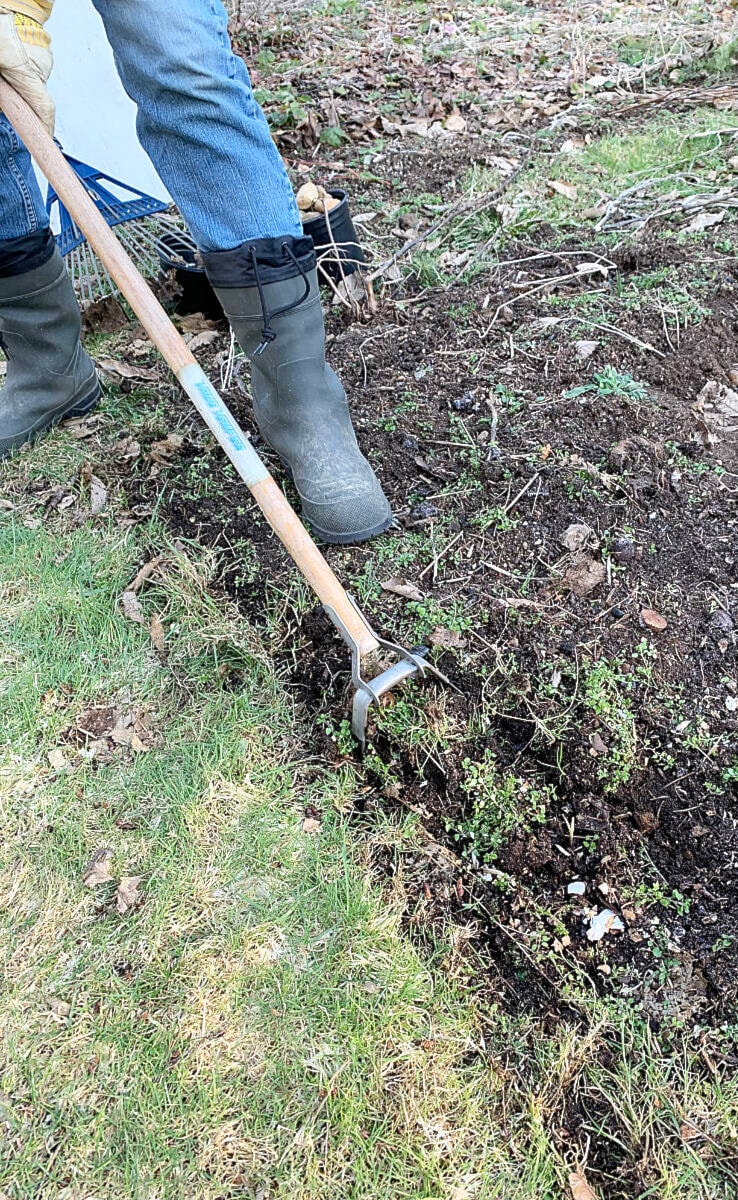By Marion Waters
When is a good time to add nutrient-rich organic matter to your soil?
Right now!
Fall and spring are ideal times to add amendments to your garden. After the harvest of last season’s crops, many of the nutrients in your soil were depleted and now need to be replenished. Additions of compost or composted manures not only increase nutrients but also help your soil drain better, loosen it to create more oxygen for plants, and improve texture to help anchor plant roots. Taking care of your soil is the first step in growing robust healthy plants.
If you top-dressed or mulched with un-composted seaweed, straw, manure, leaves, or other plant matter in the fall, lightly work in that layer of material now so that it will be fully composted by the time you are ready to start spring planting. You may find that some materials have only partially composted, such as leaves. Those will need to be removed and added to your compost bin or pile in order to finish the job. Also, if you planted cover crops to use as green manures such as wheat or rye, work those in when they grow to about 5 cm (2 inches) tall.
If you didn’t get around to mulching in the fall, never fear! Now is a great time to empty out that kitchen composting bin. Scrape off any recent additions and put them aside to add to your newly-emptied bin or add them to a second bin. Thoroughly mix the remaining composted material and cover all veggie, flower and shrub beds with a 2.5 - 5 cm (1-2 inch) thick layer. Ideally, you should weed the area first. If you are keen and energetic, this can mean a thorough going-over to remove every weed by hand. Or you can use a stirrup hoe and simply slip it under the weeds to dislodge the roots, being careful not to damage any of your emerging perennials. If you are short of time or just lazy, you may be lucky and the organic matter will smother young weed seedlings – but it may feed them instead! In that case, you can tackle them as they emerge, like a game of whack-a-mole (or whack-a-weed in this case).
Although a surprising quantity of soil can be created in one backyard kitchen compost bin, you may find that you do not have a sufficient amount to cover all of your beds, so you may have to purchase some. Any organic compost mixture or composted manure will work. If you have a small garden then a few bags from your local hardware store will do. However, if you have an extensive garden like mine, you may wish to go bigger. We usually purchase one or two cubic meters of compost from our local garden center or the community composting depot each spring.
Many perennials are already poking out of the ground. Simply spread your compost around existing plants and shrubs and scratch it in with your (gloved) hands. This is preferable to using tools because you can actually feel if you are getting close to any shoots or roots. Bear in mind that some manures are very concentrated and can burn tender young seedlings, particularly if they are still undergoing the composting process. One strategy is to mix them with some additional topsoil before using. I remember topping up my whole flower garden with a fish manure mixture only to see some early bulb shoots looking yellow and droopy within a few days. Either it wasn’t fully composted or I added too much. When in doubt, leave a margin of space around existing plants.
In a few weeks when your soil is dry enough to be worked, lightly rake in the soil amendments so they mix with your old soil below. More mixing will occur as you plant – and nature will take care of the rest. Deep tilling is not necessary and can, in fact, be very detrimental to the health of your soil. There is an intricate web of life underground: microorganisms, invertebrates, plant matter, fungi, all working together to produce the nutrients your plants need to thrive. The less you have to disturb their work, the better.
Getting this job done well ahead of time is satisfying and will set you and your garden up for a successful season ahead. An added bonus is that your garden will look neat and tidy and cared for (even if you left a few weeds underneath)!
Marion Waters is a retired educator. She is a writer, soap-maker, and lifelong avid gardener. She lives on a hobby farm in Black Creek.
References:
www.almanac.com/soil-preparation-how-do-you-prepare-garden-soil-planting
Cogger, C. (2010). Soil Science. Chapter 3, Master Gardener Training Manual. Washington State University Extension.
Herriot, C. (2010). January. Chapter 1, The Zero-Mile Diet: A Year-Round Guide to Growing Organic Food. Harbour Publishing.
Solomon, S. (2007). Soil. Chapter 2, Growing Vegetables West of the Cascades. Sasquatch Books.

